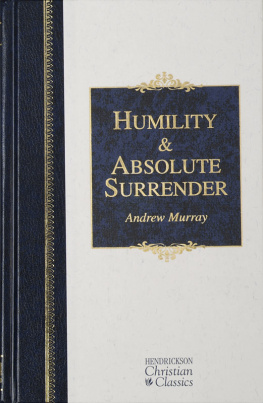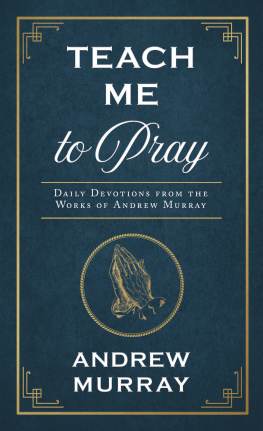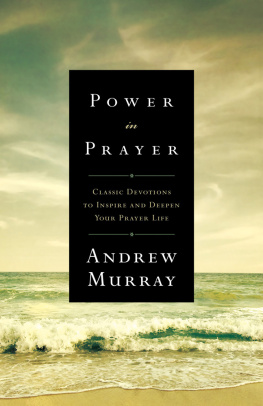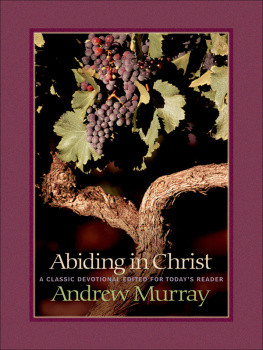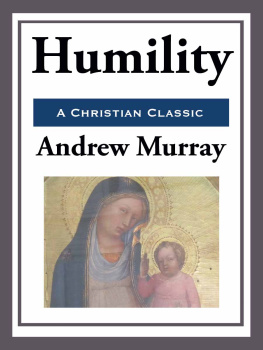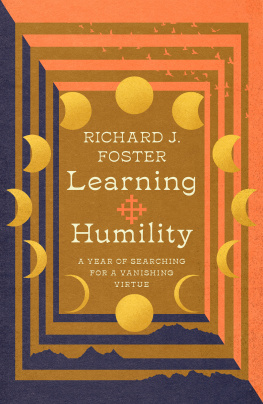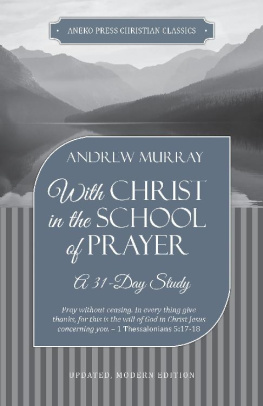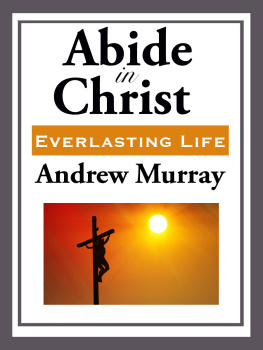All rights reserved. No part of this book may be reproduced or transmitted in any form or by any means, electronic or mechanical, including photocopying, recording, or by any information storage and retrieval system, without permission in writing from the publisher.
Due to technical issues, this eBook may not contain all of the images or diagrams in the original print edition of the work. In addition, adapting the print edition to the eBook format may require some other layout and feature changes to be made.
PREFACE
HENDRICKSON CHRISTIAN CLASSICS EDITION
Andrew Murray
(18281917)
A s a child, Andrew Murrays world spanned two continents, Africa and Europe; but ultimately his preaching, teaching, and writing fueled spiritual awakening and revival with a worldwide impact.
Andrew Murray was born in 1828 in South Africa, into a Dutch Reformed parsonage. At age ten he and a brother sailed to Scotland for schooling and later to Holland for theological studies, before returning ten years later to South Africa for pastoral ministries of their own.
At first Andrews very youth was a novelty. Dynamic in demeanor and in delivery, the young preacher spoke with loving but somewhat fearsome authority, making a name for himself as he itinerantly served a rural parish that covered fifty thousand square miles. His first book, written when he was thirty, with the help of his young wife, Emma, was a Life of Christ for Children, a resource for his scattered parishioners.
In 1860 he took a more urban church, in Worcester. Like his father before him, Andrew for years had been praying for spiritual awakening in South Africa. But when revivalaccompanied by the sound of approaching wind and outbursts of emotionbroke out in his Worcester parish, he didnt recognize it for what it was. He tried to squelch the confusion, until advised otherwise by a stranger who had been to the States and witnessed contemporary American revivals.
In Andrew Murray: The Authorized Biography, Leona Choy notes that Andrews prayer for revival was as much for himself as for his people. And God answered his prayer. As an older man he briefly wrote of his own experience. God poured out his Spirit there [in Worcester] in connection with my preaching... and a very unspeakable blessing came to me. Shortly after this he wrote his exhortational classic, Abide in Christ, based on the John 15 image of Jesus as the Vine. Looking back, he admitted, I had not then experienced all that I wrote of. But he experienced a continually deeper experience with Christ. For himself, he seemed not as interested in naming a specific day when he was baptized with the Holy Spirit. He wrote, again as an older man,
I have learned to place myself before God every day, as a vessel to be filled with his Holy Spirit.... If there is one lesson that I am learning day by day, it is this: that it is God who worketh all in all.
It is God who justifies and who sanctifies and who empowers us for service.
Andrews leadership qualities were evident beyond the pulpit. Before he was thirty-five years old, he was selected as his denominations synod moderator. In Cape Town, where he pastored briefly, he was the first president of the progressive Young Mens Christian Association. Moving to a smaller town of Wellington, he founded the publication, The Bible and Prayer Union, a Bible-reading calendar and devotional meant for his congregation, but eventually enjoying a wide subscription. In time, he started a teacher-training school for young women, based on the American model of what is now Mount Holyoke College in Massachusetts, and also a boarding school training young men to be missionaries. Whats more, his educational and evangelistic vision seemed blind to class or race or political persuasionin a country deeply divided even in his day.
Though he traveled and preached on occasion in Europe and in the States, his greatest legacy was in his writings, comprising some 240 books and tracts, generally written to Christian believers, introducing them to and leading them into a dynamic relationship with Christ, whose Holy Spirit lives within; as a heart is surrendered to Christ, the Spirit fills that heart and empowers it to maintain a walk of holiness and service.
Many of his books were based on sermon series or talks, but his output would have been reduced if not for a mysterious throat ailment that rendered him virtually voiceless for two years, in his early fifties. Providentially, he used the time to write. And this season of suffering and forced sabbatical forged a kinder, gentler Murray, who understood the humility he would eventually discuss in depth in twelve messages, published in 1895 as Humility: The Beauty of Holiness. Approaching age eighty, Murray names humility as the highest virtue of the creature, and the root of every virtue. Conversely he notes that pride, or the loss of this humility, is the root of every sin and evil. People who knew the elder Murray recognized the fruit of his walk, his life exuding an age-related authority that comes with one having walked his talk.
In his later years, many of his writings focused on sanctification and on prayer, particularly intercession. We might use the word sermons to describe the addresses selected for inclusion in Absolute Surrender, the other text in this volume; each address is tied to and explicates a scriptural text. As organized, each chapter is self-contained and complete unto itself, yet chapters build on each other, giving insight into a theme summarized in a hymn Murray quotes without attribution. (The hymn is by an American evangelist known to his contemporaries as Major Whittle, the title honoring his reputation as a Civil War hero.)
Moment by moment, Im kept in his love;
Moment by moment, Ive life from above;
Looking to Jesus, the glory doth shine;
Moment by moment, Oh Lord, I am Thine.
Both of these small books call Murrays readersthose in his own generation as well as us a century laterto a life of holiness and virtue, empowered not by our own strength but by the indwelling Holy Spirit.
HUMILITY:
THE BEAUTY OF HOLINESS
Originally published in 1859
PREFACE
TO THE ORIGINAL EDITION
T here are three great motives that urge us to humility. It becomes me as a creature, as a sinner, as a saint. The first we see in the heavenly hosts, in unfallen man, in Jesus as Son of Man. The second appeals to us in our fallen state, and points out the only way through which we can return to our right place as creatures. In the third we have the mystery of grace, which teaches us that, as we lose ourselves in the overwhelming greatness of redeeming love, humility becomes to us the consummation of everlasting blessedness and adoration.
In our ordinary religious teaching, the second aspect has been too exclusively put in the foreground, so that some have even gone to the extreme of saying that we must keep sinning if we are indeed to keep humble. Others again have thought that the strength of self-condemnation is the secret of humility. And the Christian life has suffered loss, where believers have not been distinctly guided to see that, even in our relation as creatures, nothing is more natural and beautiful and blessed than to

